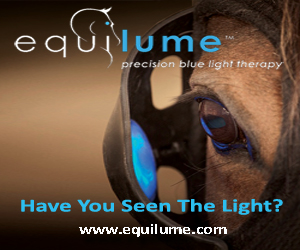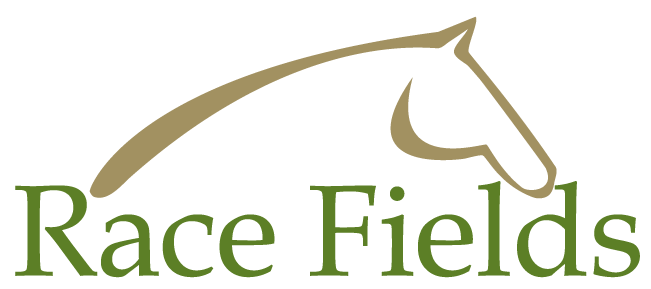
Blue lights dotted across the landscape of the global Thoroughbred breeding hubs from Hunter Valley, Australia, to the Bluegrass of Kentucky, are becoming a common sight in the post-dusk hours as a new equine breeding technology is embraced by horse breeders.
The source of the light – an innovative mobile lighting device for horses called The Equilume Light Mask that was developed in Ireland by University College Dublin researchers Dr Barbara Anne Murphy and Professor John Sheridan, whose research identified for the first time the optimum light level required to advance the breeding season in horses.
To understand how the technology works we must first understand the annual reproductive cycle of the mare. Horses are long-day seasonal breeders. The natural reproductive period coincides with the light-filled days between November and April, when the environment is optimal for the survival of offspring. However, the universal birth date for Thoroughbreds of August 1st poses a number of significant problems for breeders, including difficulty ensuring mares are reproductively active early in the year, longer pregnancies and lower average foal birth weights.
Artificial lighting programmes to advance the breeding season of mares have been used for decades by horse breeders to overcome these problems. Mares are often maintained indoors under stable lighting or outdoors in pens under floodlights until 11 p.m. nightly for eight to ten weeks beginning around July 1st. The artificially extended day length acts to inhibit a hormone called melatonin and fools the mare’s reproductive system into activating earlier in the year, in time for the official start of the breeding season on September 1st. Now, Irish researchers have developed a novel automated headpiece for horses that provides just the right amount of blue light to a single eye to successfully advance the breeding season as effectively as the traditional method of stable lighting. An ideal application is for use on maiden mares in their final months of training to kick-start their reproductive activity before beginning a stud career.
For pregnant mares, the light mask has been shown to prevent prolonged gestation lengths in mares with a history of going past their due dates and has even been shown to increase average foal birth weights.
An additional response to the light treatment using Equilume is reportedly the early shedding of the winter coat, a desirable consequence for many performance and sales animals. In fact, a recent scientific study conducted by the Japanese Racing Association revealed that an extended light regime early in the year increases muscle mass in Thoroughbred colts and improves their response to training. For many competition horses it will be beneficial to not have to clip through the winter months and have a summer coat earlier in the year. Horses have been found to shed out after only 6 weeks wearing the lights mask.
Work began on the development of the light mask in early 2011 at University College Dublin. Following an initial year of successful trials on Thoroughbred farms across three continents (Ireland, Kentucky and Japan) Dr Murphy was awarded a grant from the Irish government to commercialise the technology improve the prototype and conduct more trials. After another year of trials the Equilume Light Mask product was finally launched for the first time in June 2013 in New Zealand and Australia ahead of the Southern Hemisphere’s breeding season.
“We had a very short amount of time to market the product initially before the start of light therapy programmes in Australia and New Zealand, but the response by the Aussie and Kiwi breeders was amazing. It just made sense to them to leave horses outside and the cost-benefits were obvious. What blew us away was their willingness to try something new and their openness to this new concept.!,” states Dr. Murphy. Feedback from the first customers, among them many of Australasia’s leading Thoroughbred breeding establishments, has been very positive.
"I was delighted with the benefits we gained from our first season using the Equilume light masks in 2013. Aside from the obvious efficiencies of not having to box our mares under lights, our barren and maidens had strong heats in early September with excellent fertility. Without any hesitation, we will be using the light masks again next season". Gordon Cunningham Curraghmore Stud New Zealand.
Dr Murphy adds; “Our first year has not been without hiccups. The hardest part of the light mask development has been the production of a device that will fit comfortably for an extended duration on a horse under all weather conditions and in many different paddock environments. Our initial prototypes only had a battery life of two weeks and then required a battery change, often resulting in electronics getting moisture damage. Now we have a battery that lasts over 5 months but damage caused by horses rubbing it off fences, rolling in mud, -30 degree conditions in some countries etc. is a constant design battle. We are getting there and we greatly appreciate all our customers whose constant feedback and tolerance of us swapping out faulty or broken units means the ultimate success of this reproductive tool so that our horses are happier and healthier and our breeders pockets are that bit heavier”.
The light mask is designed to be activated at 4pm between June 15th and July 1st (Southern Hemisphere) in advance of the breeding season. It will then automatically turn on at the same time each day and automatically switch itself off a at 11pm. Only one activation on the first day is needed. It means breeders can leave their mares outdoors with confidence that their horses are receiving the right amount of light to activate their reproductive systems. It saves costs in terms of labour and bedding. The Equilume mask also comprises a built in light sensor such that the light will only come on when low levels of light are detected at dusk.
Further information on the product, the research and testimonials from customers can be found at www.equilume.com
 InglisDigitalAUS
InglisDigitalAUS InglisDigitalUSA
InglisDigitalUSA







